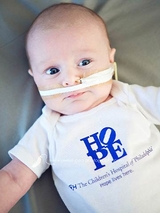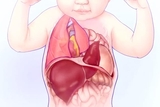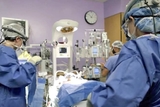Hugh’s Story

When Molly went for her 20-week prenatal anatomy scan, she and her husband, James, received shattering news: their unborn son had congenital diaphragmatic hernia (CDH), a rare condition in which the diaphragm – the muscle that separates the chest from the abdomen – fails to close during prenatal development. This allows abdominal organs (the stomach, intestines, and/or liver) to move into the chest, crowding the lungs and heart and preventing the lungs from growing normally.
Doctors in their central Illinois town made it clear that they weren’t equipped to handle this anomaly. So, Molly and James did their research. They discovered that the Center for Fetal Diagnosis and Treatment at Children’s Hospital of Philadelphia (CHOP) had the deepest experience, treating more than 1,600 CDH cases – more than any other hospital in the world. After flying to Philadelphia to meet the team, their path forward was clear.
“As we walked out of the hospital, I remember saying to James, ‘Well, at least we know where we’re going,’” Molly says. Adds James, “Looking back, every step of the way, there was a team of people with different skill sets that would serve and guide us however we needed.”
James, Molly and their then two-year-old son moved to Philly temporarily a month before Molly’s due date. She gave birth in CHOP’s Garbose Family Special Delivery Unit (SDU), which allowed newborn Hugh’s monitoring and treatment to begin immediately.
For babies with congenital anomalies like CDH, the care provided in the first hour of life is directly related to their future health, so it is critical to have the most experienced specialists there from the very beginning. Every detail matters.
Surgery to repair CDH
Holly Hedrick, MD, FACS, performed the surgery to repair the hole in Hugh’s diaphragm when he was 10 days old, and he was discharged to return home at 6 weeks.
A few weeks after getting home, they had a scare. Hugh began throwing up everything Molly fed him through his nasogastric (NG) tube. She reached out to Dr. Hedrick, who asked, “What does your mom gut tell you?”
“I said, ‘My mom gut says something’s wrong,’” Molly says. “Dr. Hedrick told us to bring Hugh back as soon as possible.”

Within 36 hours they were in Philadelphia again. Hugh had exploratory surgery, which revealed a bowel obstruction that developed from adhesions formed after his first surgery.
“That’s where CHOP flourishes,” James says. “If the lines of communication stay open, when you need them the most, they'll be there to help you.”
Hugh is now 10, the second of James and Molly’s four children. Molly describes him as a healthy, funny, happy kid that everyone loves. He’s obsessed with sports – mostly football. He’s monitored by CHOP’s Pulmonary Hypoplasia Program once every two years. But the family comes to Philly more often, thanks to their love of the city, and the Eagles in particular.
“Even though we live in Illinois, every single time we meet someone new, Hugh tells them, ‘I’m from Philly,’” Molly says with a laugh. “He’s proud to have been born in Philly.”

FAQs about CDH
This information can help you make choices about your child’s care and choose a CDH treatment center that is right for you. Learn more about how we can help you, and what questions you should ask any care team.

Best outcomes for CDH
CDH is an extremely complex condition that requires delicate care. Comprehensive management by an experienced team is vital — here's what you can expect at CHOP.

Parker's CDH journey
Like many expectant parents, Janelle and Major were eagerly anticipating their 20-week ultrasound. What they didn’t anticipate was the news that their baby may have a life-threatening condition. Fast forward 11 years, and Parker continues to excel in every way.